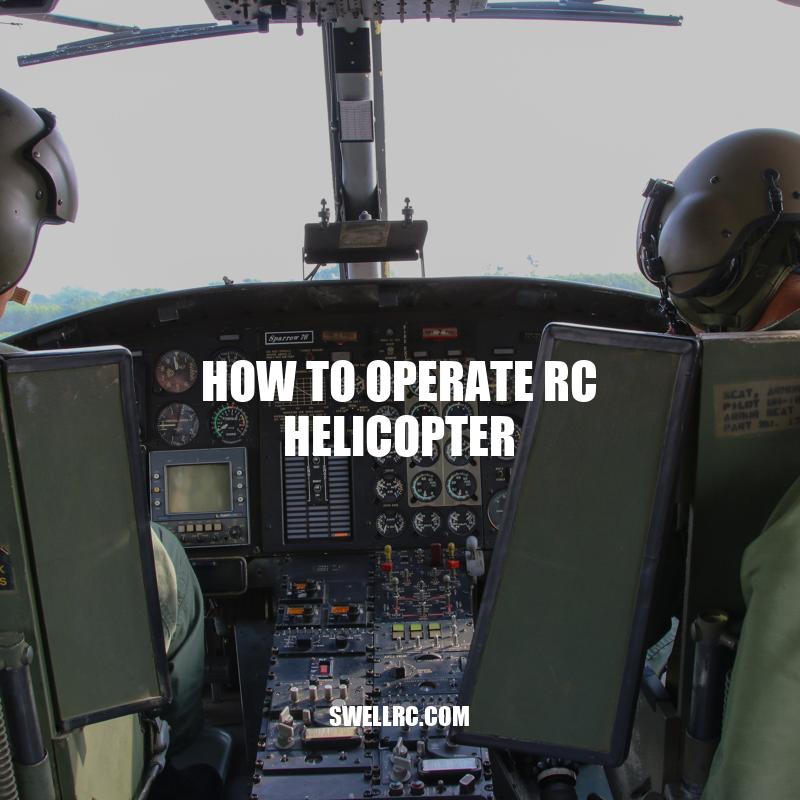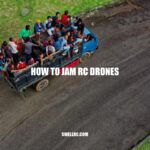Mastering the Controls: How to Operate RC Helicopter
RC helicopters are an exciting and engaging hobby for people of all ages. These miniature flying machines are designed to be piloted with a remote control and offer a fun and interactive way to experience the thrill of flight. However, operating an RC helicopter may seem daunting for beginners, especially when it comes to understanding the different controls and maneuvers. While it may take some practice to become a skilled RC helicopter operator, learning the basics is easy with the proper guidance and understanding. This article will outline the necessary equipment, explain the different controls and maneuvers, and provide tips on how to safely operate an RC helicopter, regardless of your skill level. So, whether you’re a hobbyist looking to take flight for the first time or an experienced operator wanting to perfect your techniques, read on to learn how to operate an RC helicopter like a pro.
Getting Started
To operate an RC helicopter, there is some essential equipment that you will need. Here are some things to keep in mind when getting started:
- RC helicopter: Choose an RC helicopter that is suitable for your skill level.
- Remote control: You will need a remote control to fly the RC helicopter. Choose the right remote control model for your helicopter type.
- Batteries: Check how many batteries you need for your remote control and your RC helicopter before making your purchase.
- Charger: Make sure you have a proper charger to charge the batteries before and after each flight.
If you are buying your first RC helicopter, consider a mini or micro model. They are relatively easy to operate, and you can practice new moves without the risk of destroying an expensive model. Online hobby shops are great resources for buying RC helicopters and necessary equipment. Websites like HobbyKing and Tower Hobbies offer information about different models, and prices are competitive.
How hard is it to fly a RC helicopter?
- Flying a remote control (RC) helicopter can be challenging for beginners, but with practice, anyone can learn how to fly one.
- The level of difficulty also depends on the type of RC helicopter you are flying. Some are easier to control while others require more experience and skill.
- To make learning easier, it’s recommended to start with a basic model and gradually work your way up to more advanced ones.
- It’s also important to follow safety guidelines and fly your RC helicopter in an open and unobstructed area.
For more information and tips on flying RC helicopters, check out hobbyist websites such as rchelicopterfun.com or products like the Blade Nano S2 which is designed for beginners.
Learning the Controls
Learning the controls for an RC helicopter is vital for safe and successful flight. Here are the essential controls to keep in mind:
| Control | Function |
|---|---|
| Throttle | Controls the upward or downward movement of the RC helicopter. |
| Rudder | Controls the movement of the RC helicopter left or right. |
| Elevator | Controls the forward or backward movement of the RC helicopter. |
Here are some methods to learn and familiarize yourself with the controls:
- RC Flight Simulator: You can use an RC flight simulator to practice operating an RC helicopter without risk of crashing.
- Start Slow: Begin by practicing basic maneuvers like takeoff, hovering, and landing to get used to the controls.
- Ask for Help: If you have difficulties learning the controls, do not hesitate to join an online community or local club for guidance and support.
Remember, mastering the controls is not something that happens overnight. To become proficient, you need to practice regularly and have patience.
What are the controls of the RC helicopter?
The controls of an RC helicopter typically consist of:
- Throttle control
- Pitch control
- Yaw control
- Roll control
The throttle control adjusts the power of the main rotor blades, allowing the helicopter to ascend or descend. The pitch control adjusts the pitch of the rotor blades, controlling forward or backward movement. The yaw control adjusts the helicopter’s tail rotor, controlling left or right movement. Finally, the roll control adjusts the cyclic pitch of the rotor blades, controlling side-to-side movement.
If you’re looking to purchase an RC helicopter or learn more about flying one, be sure to check out reputable websites and products such as Horizon Hobby or Blade Helicopters.
Basic Maneuvers
Once you’ve familiarized yourself with the controls of an RC helicopter, it’s time to learn some basic maneuvers. Here are some essential maneuvers to know:
- Takeoff: Slowly increase the throttle to lift the RC helicopter off the ground.
- Hovering: Keep the RC helicopter in one position at a set altitude by adjusting the throttle, rudder, and elevator.
- Landing: Slowly decrease the throttle to bring the RC helicopter to the ground.
Here are some tips on performing these basic maneuvers:
- Practice, Practice, Practice: Take the time to practice each maneuver and become proficient before moving onto more complex ones.
- Check Altitude: Make sure you are flying at a comfortable altitude to avoid crashing or damaging the RC helicopter.
- Keep it Smooth: Move the controls slowly and smoothly to avoid sudden or jerky movements.
Some RC helicopters come with instructional manuals which may provide additional guidance on performing basic maneuvers. Additionally, some websites offer video tutorials that can be helpful for visual learners.
How do you steer a RC helicopter?
To steer a remote control (RC) helicopter, you need to understand the function of the four controls on your remote:
- Throttle control: Controls the height of the helicopter.
- Pitch control: Helps the helicopter move forward and backward.
- Yaw control: Allows the helicopter to turn left or right.
- Roll control: Allows the helicopter to move sideways.
It’s essential to practice with your RC helicopter in open areas, and once you’re comfortable with the controls, you can perform more complex maneuvers like hovering, pirouettes, and flips.
If you’re interested in purchasing an RC helicopter, consider checking out websites like Horizon Hobby, Tower Hobbies, or RC Planet for a wide selection of products.
Advanced Maneuvers
Once you have mastered basic maneuvers, it’s time to move on to more challenging ones. Here are some advanced maneuvers to try:
- Flips: This maneuver involves a 360-degree rotation while moving forward or backward.
- Rolls: A roll involves a sideways rotation to the left or right while moving forward or backward.
- Climbing Turns: This maneuver involves climbing while making a 180-degree turn.
Advanced maneuvers require more skill, experience, and practice. Here are some tips for performing advanced maneuvers:
- Master the Basics First: Practice the basic maneuvers until they become second nature before attempting advanced ones.
- Progress Slowly: Attempt one new maneuver at a time and continue practicing until it’s mastered before moving on to the next.
- Start high: To avoid collisions and damage to your RC helicopter, begin advanced maneuvers at a safe height.
There are many online resources for learning new maneuvers, including video tutorials and tips from experienced RC helicopter pilots. Some websites also offer RC helicopter classes and workshops for those looking for more structured learning opportunities.
What is an advanced maneuver in skydiving?
An advanced maneuver in skydiving refers to a challenging aerial maneuver executed by experienced skydivers. These maneuvers require advanced skills, techniques, and extensive training to perform safely. Some examples of advanced maneuvers in skydiving are:
- Tracking – Flying your body horizontally away from the exit point to gain as much distance as possible
- Angle flying – A flight technique where the body is oriented at an angle relative to the ground
- Freeflying – A form of skydiving where participants perform acrobatic body positions in the air
- Canopy piloting – A competitive sport where participants maneuver their canopies through a set of course challenges, such as speed, accuracy, and distance challenges
If you’re interested in learning more about skydiving or are looking for a dropzone that caters to advanced skydivers, websites like dropzone.com offer a wealth of information and user reviews. Additionally, there are advanced skydiving courses and programs available for those looking to take their skills to the next level.
Maintenance and Safety
Proper maintenance and safety are essential for the longevity of your RC helicopter and your own safety. Here are some tips to ensure your RC helicopter stays in top condition and the flight is safe:
- Regular Maintenance: Conduct routine inspections and clean your RC helicopter regularly. Replace parts as needed and keep the blades in good condition.
- Checklist: Before taking off, create a checklist to ensure you have followed all safety protocols and your RC helicopter is functioning correctly.
- Protective Gear: Always wear appropriate protective gear, including safety glasses, gloves, and a helmet.
- Safe Environment: Choose an open, outdoor area to fly your RC helicopter. Avoid obstacles and steer clear of people, animals, and buildings.
- Battery Safety: Keep batteries in good condition and never overcharge them. Always use the recommended batteries for your RC helicopter and never puncture or disassemble them.
There are numerous resources available to ensure safe and responsible flying. For example, the Academy of Model Aeronautics offers guidelines and safety information for RC pilots. You can also find local training workshops and clubs that offer guidance, tips, and a community of like-minded individuals.
What is the best long lasting RC helicopter?
When it comes to finding the best long lasting RC helicopter, there are a few key factors to consider such as durability, motor power, and battery life. Based on expert reviews and customer feedback, some of the top options in the market include:
- Blade 230 S V2 RTF: This helicopter features a strong, lightweight frame and a brushless motor for reliable, long lasting performance.
- Syma S107G: This budget-friendly option is great for beginners and has proven to be durable with its solid construction and easy-to-use controls.
- WLtoys V911 RC Helicopter: This option is popular for its long battery life and ability to withstand crashes thanks to its metal frame and strong, flexible blades.
When researching and purchasing a long lasting RC helicopter, it’s important to read reviews and consider the quality of the materials used to ensure longevity. Websites like Amazon and Best Buy offer a variety of options and customer reviews to help make an informed decision.
Conclusion
Learning how to operate an RC helicopter can be a fun and rewarding hobby. With the right equipment, proper training, safety measures, and maintenance, you can enjoy safe and successful flights. Follow the basic steps from getting started to mastering advanced maneuvers, and always prioritize safety. Joining a local RC club or accessing online resources can also provide valuable information and support. Once you’ve mastered the basics, you can experiment and push yourself to new heights. Enjoy the thrill of flying an RC helicopter and remember to always fly safely and responsibly.



